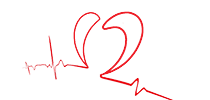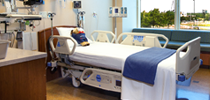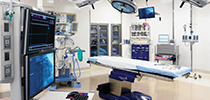Treatments for Vein Disease

Veins are the part of your circulatory system that bring oxygen-depleted blood back to the heart, so it can be pumped back to the lungs. Veins work through a system of one-way valves that keep blood flowing toward the heart. When damage occurs to the veins or the valves, it can allow blood to flow away from the heart and stay in the veins longer than it should.
The beginning stages of vein disease are sometimes seen as cosmetic but, if left untreated, can lead to pain, blood clots, and potentially a pulmonary embolism.
There are several types of vein disease, all of which have different symptoms and treatments.
- Varicose veins are twisted, enlarged veins that can be seen on the skin’s surface, frequently on the legs. They are often thought of as cosmetic but can be a medical issue if left untreated.
- Venous insufficiency is when the valves in the veins do not work well. This allows blood to pool in the legs, which causes swelling, changes to the skin, and blood clots.
- Deep vein disease, commonly known as deep vein thrombosis, happens when clots form in the deep veins. DVT most often occurs in the lower extremities and can cause swelling and pain in the affected limb. If left untreated, a clot can break off and travel to the lungs, where it becomes a pulmonary embolism.
Treatments for vein disease
There are many available treatments for vein disease that your doctor may recommend based on your health history and the severity of your condition.
Anticoagulants, commonly referred to as blood thinners, reduce your blood’s ability to clot and are used as both treatment and prevention for blood clots in patients who have vein disease.
In emergency situations when a clot has already occurred, clot-busting medications called thrombolytics are used to break apart blood clots. These medications may be used during a hospitalization or when being transported to the hospital for a stroke, heart attack, or pulmonary embolism.
Endovenous ablation treats varicose veins with a non-surgical outpatient procedure in which doctors use a local anesthetic, make a small incision, and use a laser or radiofrequency to seal off varicose veins.
When medications cannot dissolve a clot or it has become life threatening, a thrombectomy surgically removes blood clots from the veins to reestablish blood flow to organs and prevent future problems.
Some patients cannot take blood thinners, and their doctor may recommend a vena cava filter. This filter is a permanent or retrievable mesh device inserted in the large vena cava vein to catch and filter any clots before they reach the lungs and cause a pulmonary embolism.
Vein surgery includes varicose vein stripping and ligation surgeries in which unhealthy veins are tied off and removed from the leg to reestablish blood flow through healthy veins.
Compression stockings or bandages hold pressure on the legs to treat varicose veins, chronic venous insufficiency, and deep vein thrombosis by preventing blood from pooling and reducing swelling. They are especially useful for those who sit for long periods of time.
Lifestyle changes, like maintaining a healthy weight, increasing activity levels, and elevating your feet, can also be used to combat the effects of vein disease.
If you are experiencing any symptoms of vein disease, even symptoms you consider to be cosmetic, it’s important to see your doctor and develop a treatment plan. Contact Oklahoma Heart Hospital to make an appointment with one of our vein specialists.




